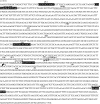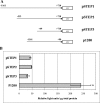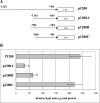Regulatory regions responsive to oxidative stress in the promoter of the human DNA glycosylase gene NEIL2
- PMID: 19945985
- PMCID: PMC2825343
- DOI: 10.1093/mutage/gep058
Regulatory regions responsive to oxidative stress in the promoter of the human DNA glycosylase gene NEIL2
Abstract
Reactive oxygen species (ROS) generated endogenously or from exogenous sources produce mutagenic DNA lesions. If not repaired, these lesions could lead to genomic instability and, potentially, to cancer development. NEIL2 (EC 4.2.99.18), a mammalian base excision repair (BER) protein and ortholog of the bacterial Fpg/Nei, excises oxidized DNA lesions from bubble or single-stranded structures, suggesting its involvement in transcription-coupled DNA repair. Perturbation in NEIL2 expression may, therefore, significantly impact BER capacity and promote genomic instability. To characterize the genetic and environmental factors regulating NEIL2 gene expression, we mapped the human NEIL2 transcriptional start site and partially characterized the promoter region of the gene using a luciferase reporter assay. We identified a strong positive regulatory region from nucleotide -206 to +90 and found that expression from this region was contingent on its being isolated from an adjacent strong negative regulatory region located downstream (+49 to +710 bp), suggesting that NEIL2 transcription is influenced by both these regions. We also found that oxidative stress, induced by glucose oxidase treatment, reduced the positive regulatory region expression levels, suggesting that ROS may play a significant role in regulating NEIL2 transcription. In an initial attempt to characterize the underlying mechanisms, we used in silico analysis to identify putative cis-acting binding sites for ROS-responsive transcription factors within this region and then used site-directed mutagenesis to investigate their role. A single-base change in the region encompassing nucleotides -206 to +90 abolished the effect of oxidative stress that was observed in the absence of the mutation. Our study is the first to provide an initial partial characterization of the NEIL2 promoter and opens the door for future research aimed at understanding the role of genetic and environmental factors in regulating NEIL2 expression.
Figures







Similar articles
-
Single nucleotide polymorphisms 5' upstream the coding region of the NEIL2 gene influence gene transcription levels and alter levels of genetic damage.Genes Chromosomes Cancer. 2008 Nov;47(11):923-32. doi: 10.1002/gcc.20594. Genes Chromosomes Cancer. 2008. PMID: 18651651
-
Requirements for DNA bubble structure for efficient cleavage by helix-two-turn-helix DNA glycosylases.Mutagenesis. 2020 Feb 13;35(1):119-128. doi: 10.1093/mutage/gez047. Mutagenesis. 2020. PMID: 31784740
-
NEIL1 and NEIL2 Are Recruited as Potential Backup for OGG1 upon OGG1 Depletion or Inhibition by TH5487.Int J Mol Sci. 2021 Apr 27;22(9):4542. doi: 10.3390/ijms22094542. Int J Mol Sci. 2021. PMID: 33925271 Free PMC article.
-
DNA glycosylase NEIL2 functions in multiple cellular processes.Prog Biophys Mol Biol. 2021 Sep;164:72-80. doi: 10.1016/j.pbiomolbio.2021.03.003. Epub 2021 Mar 20. Prog Biophys Mol Biol. 2021. PMID: 33753087 Free PMC article. Review.
-
Functional roles and cancer variants of the bifunctional glycosylase NEIL2.Environ Mol Mutagen. 2024 Apr;65 Suppl 1:40-56. doi: 10.1002/em.22555. Epub 2023 Jun 26. Environ Mol Mutagen. 2024. PMID: 37310399 Review.
Cited by
-
8-Oxoguanine targeted by 8-oxoguanine DNA glycosylase 1 (OGG1) is central to fibrogenic gene activation upon lung injury.Nucleic Acids Res. 2023 Feb 22;51(3):1087-1102. doi: 10.1093/nar/gkac1241. Nucleic Acids Res. 2023. PMID: 36651270 Free PMC article.
-
Research progress on the role of the NEIL family in cancer.Front Cell Dev Biol. 2025 Jul 21;13:1612329. doi: 10.3389/fcell.2025.1612329. eCollection 2025. Front Cell Dev Biol. 2025. PMID: 40761744 Free PMC article. Review.
-
Association of polymorphisms in oxidative stress genes with clinical outcomes for bladder cancer treated with Bacillus Calmette-Guérin.PLoS One. 2012;7(6):e38533. doi: 10.1371/journal.pone.0038533. Epub 2012 Jun 12. PLoS One. 2012. PMID: 22701660 Free PMC article.
-
Perturbation of base excision repair sensitizes breast cancer cells to APOBEC3 deaminase-mediated mutations.Elife. 2020 Jan 6;9:e51605. doi: 10.7554/eLife.51605. Elife. 2020. PMID: 31904337 Free PMC article.
-
The current state of eukaryotic DNA base damage and repair.Nucleic Acids Res. 2015 Dec 2;43(21):10083-101. doi: 10.1093/nar/gkv1136. Epub 2015 Oct 30. Nucleic Acids Res. 2015. PMID: 26519467 Free PMC article. Review.
References
-
- Nohl H, Kozlov AV, Gille L, Staniek K. Cell respiration and formation of reactive oxygen species: facts and artefacts. Biochem. Soc., Trans. 2003;31:1308–1311. - PubMed
-
- Fortini P, Pascucci B, Parlanti E, D'Errico M, Simonelli V, Dogliotti E. The base excision repair: mechanisms and its relevance for cancer susceptibility. Biochimie. 2003;8:1053–1071. - PubMed
-
- Wiederhold L, Leppard JB, Kedar P, et al. AP endonuclease-independent DNA base excision repair in human cells. Mol. Cell. 2004;15:209–220. - PubMed
-
- Zienolddiny S, Campa D, Lind H, Ryberg D, Skaug V, Stangeland L, Phillips DH, Canzian F, Haugen A. Polymorphisms of DNA repair genes and risk of non-small cell lung cancer. Carcinogenesis. 2006;27:560–567. - PubMed
-
- Abdel-Rahman SZ, El-Zein RA. The 399Gln polymorphism in the DNA repair gene XRCC1 modulates the genotoxic response induced in human lymphocytes by the tobacco-specific nitrosamine NNK. Cancer Lett. 2000;159:63–71. - PubMed
Publication types
MeSH terms
Substances
Grants and funding
LinkOut - more resources
Full Text Sources
Research Materials

